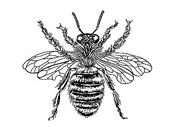Nearly two hundred years ago Samuel Taylor Coleridge famously – or infamously? – wrote that summer set in “with its usual severity.” Much the same could be written today, on this summer solstice.
Texas has been in the national spotlight this past week for its record high heat index readings. This is where I would normally say, “Ah, but it’s a dry heat…” Alas. No. Unseasonably high humidity is pushing the “feels like” temperatures in to the stratosphere. “People don’t notice whether it’s winter or summer when they’re happy,” Anton Chekov wrote in 1898. Oh, there is no missing that it is summer in Texas right now! Even the happiest of folks know 115 degrees when they feel it. Today I am grateful for air conditioning and deodorant and iced tea.
“Heat, Ma’am! It was so dreadful, that I found there was nothing left for it but to take off my flesh and sit in my bones,” wrote Sydney Smith. Today I am also grateful for native plants and zinnias and daylilies and for the bees that dart about my garden as I sit here, sweltering in my bones.

Our native beautyberry won’t form its namesake beautiful berries for quite a while yet and their flowers are less than noteworthy and somewhat hidden under its large leaves, but that doesn’t stop the bees from partaking of its nectar. Callicarpa americana (shown above) grows three to six feet tall and wide and its berries, which grow in clusters along the branches, are an important food source for birds during the winter. In its natural habitat, beautyberry would be found growing in wet bottomlands or along waterways, but it is very adaptable to our irrigated gardens.

Echinacea, aka coneflower, was one of the first native plants in my garden 28 years ago and it remains one of my favorites. It attracts many beneficial insects and is extremely durable, even withstanding full sun, with scant supplemental watering, around my mailbox. I will periodically deadhead the spent flowers through the summer, which encourages another wave of blooms into late summer and early fall. I stop deadheading echinacea (shown above) in the fall and allow those seedheads to remain standing through the winter. It is reported that songbirds will feed on the seeds in the cold of winter, though I have never personally witnessed that in my garden. In the late winter or early spring, I will cut down any remaining coneflower stalks and scatter those seeds about the garden. In this manner, I have sown multiple stands of echinacea around my property.

Ratibida pinnata (above) is possibly one of my new favorite plants, in part because I love its common name. Grayheaded coneflower. As my “new and improved” gardens were coming together last year, I found myself drawn to BIG. And not just BIG, but – Tall plants. Big blooms. Bold botany. Plants that command your attention. Thus entered the grayheaded coneflower. At three to five feet tall, he fits the bill. Big. Yet oh, so, wispy. I also adore how delicate – and bright yellow – the petals are.

Zinnias and agastache (shown above) are a happy accidental combination. I direct sow zinnias in the garden, at first with thoughtful selection of seed and careful consideration to date and location of sowing, later with reckless abandon. A little here, a little too much there, I morph into the botanical version of Tinker Bell scattering pixie dust. But then. This happens. And I am reminded exactly why I take a lighthearted approach to gardening. Nothing by the rows. Nothing by the rules. Sometimes happenstance gardening is best. Such a beautiful way to enter summer, sitting on the patio with this amazing view.

The pollinators were out in force this morning, happily working away at pollinating my zucchini plants. (Shown above.) Last year, I fought squash vine borers something fierce. And by “something fierce,” I mean – I gave in and let them have the plants until I gave up and ripped them out and tossed them in the compost bin. This year, I sowed three to ten times more seeds than needed, of different varieties and at staggered dates. The squash vine borers? I think they were overwhelmed by their options and flew right on past. Which means zucchini is on the menu more than a handful of times each week. Zucchini bread. Zucchini lasagna. Zucchini and bean soup. Zucchini enchiladas. Zucchini muffins. In all honesty, some years are just better for one crop over another crop. Last year, I had great success with both Dragon’s Tongue and Helda beans. This year, neither one germinated well and the ones that did grow haven’t produced much. But the zucchini? This has been a very good year for the zucchini.
Keep Calm and Stay Cool. Plant something and watch it grow, what a wonderful way to honor the longest day of the year!

All photographs taken June 21st, 2023, in my zone 8a North Texas garden.

